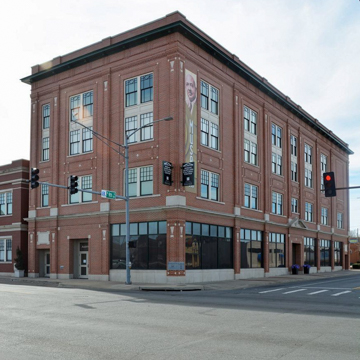In 1913 Booker T. Washington gave the dedication speech at the opening of the Mosaic Templars of America Headquarters. Blaisdell designed the structure, which was built by Windham Brothers Construction Company, an African American-owned firm based in Birmingham, Alabama. Blaisdell’s building was destroyed by fire in 2005, but the facade of this building replicates his design, and the interior of auditorium on the third floor resembles the original. Organized in 1883 by former slaves John E. Bush and Chester Keatts in order to provide burial and life insurance services to African Americans, the Mosaic Templars enjoyed steady growth, allowing the founders to hire Blaisdell as designer. The initial service of insuring the Templars’ members expanded to include a funerary monument department, a building and loan association, a national newspaper, and a medical department and hospital. The building also was often the scene of political discussions, meetings, and protests against Jim Crow restrictions. The three-and-a-half-story headquarters, visually imposing because of its situation on a busy intersection, also stood out among the lower one-and two-story commercial and entertainment establishments along the 9th Street business corridor. Two-story brick pilasters capped with concrete Doric capitals and inset geometric panels emphasize the building’s height, and brick spandrels embellished with concrete geometric insets on the second and third stories add a decorative touch. A projecting wood cornice featuring modillions and decorative brick mutules in the frieze spans the building’s north and east elevations, and a parapet wall provides more height above the cornice. In 1918 a two-story annex facing S. Broadway Street was added to the building; it burned in 1984 and was rebuilt in 2007.
Beginning shortly after the Civil War, 9th Street became the center of a growing African American neighborhood, and many black business owners located along this corridor. The Great Depression, however, forced the Mosaic Templars to terminate operations in 1930, and the building subsequently had several occupants. By the 1960s, 9th Street had begun a decline, in large part due to the construction of I-630, which saw the destruction of many buildings, both commercial and residential. The Mosaic Templars building and Taborian Hall (PU32) were two of only a handful of structures that remained comparatively intact. In the 1990s the area experienced renewal, first with the rehabilitation of Taborian Hall and second with the purchase of the Mosaic Templars building by the Mosaic Templars Building Preservation Society. In 2003, the Department of Arkansas Heritage acquired the Templars building. The structure’s subsequent revitalization as a museum showcases the history and culture of African Americans in Little Rock.















